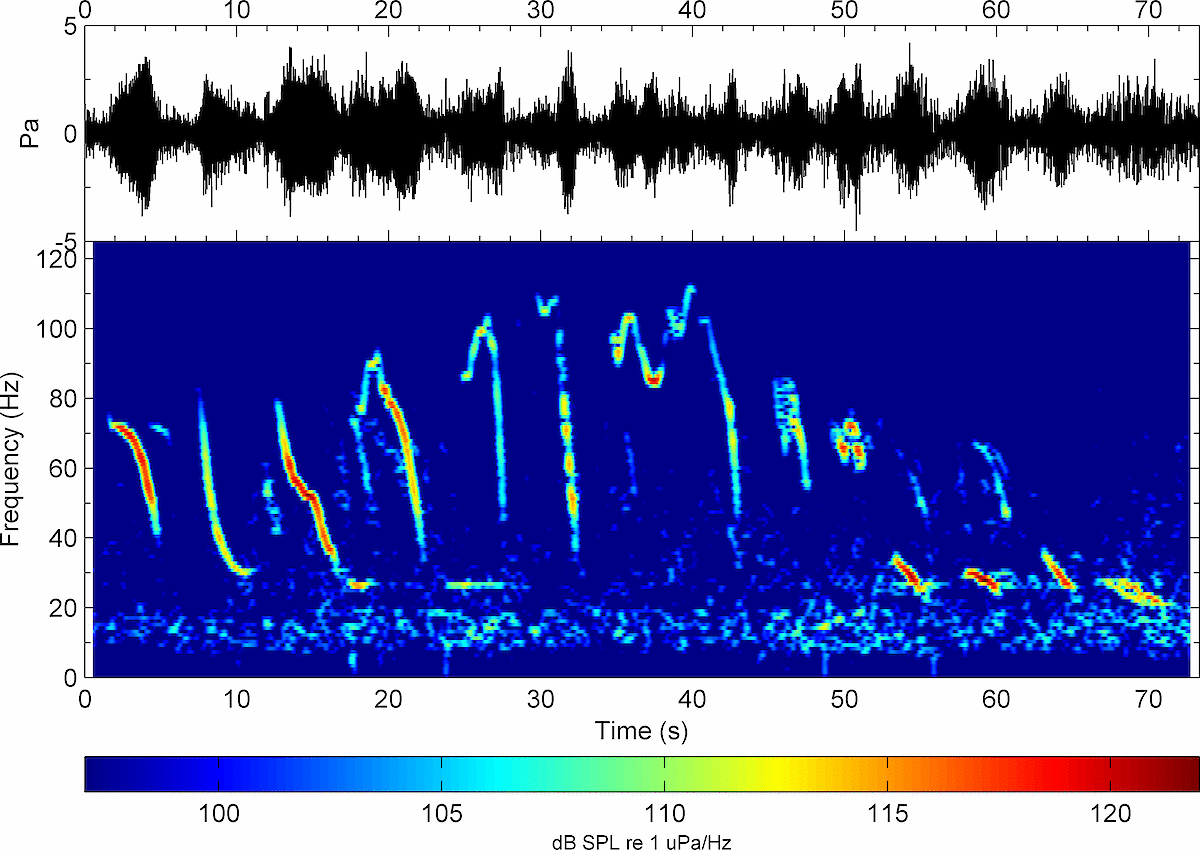【Military Sub-Plane】Author: Riding Pig Knight
If there is a submarine urgent need to get in touch with friendly ships, but enemy anti-submarine aircraft and surface ships are searching. During the search, sonar operators hear a swarm of whales singing, and they often don't think much about it. However, this is actually a secret, covert communication system that communicates by mimicking the sounds of marine mammals.
This is not a scene from a spy novel or movie, but a method of communication that the U.S. Navy once envisioned. In 1959, the Naval Electronics Laboratory began a program called "Band Groups." Under the right conditions, the sounds of certain marine mammals and the vibrations they produce can travel long distances underwater. What's more, this is so common in nature that it won't be noticed by enemies at all.

Spectrogram of blue whale sounds
Submarines can patrol large areas of the sea, perform surveillance missions and even quietly send special forces and agents behind enemy lines. Ballistic missile submarines are a key component of the U.S. "Trinity" nuclear force. But rapid communication and sharing of information with friendly forces is a long-standing problem. The biggest difficulty is that the attenuation of radio waves in seawater is very large. As radar, sonar, and other sensors continued to evolve after World War II, it was extremely dangerous for submarines to surface to emit signals. Even using communication sonar to send information during a dive is extremely dangerous. These man-made noises are very susceptible to exposure.
The basic content of the "Band Combination" program is to develop coded information from the sound recordings of whales, dolphins, sea lions and seals. Theoretically, this method is relatively simple. As the work progressed, the Navy identified many complex problems that needed to be overcome. First there was the coding problem, and then there was the noise problem, and the animal sounds recorded by naval technicians between 1959 and 1965 all had natural background noise that was difficult to remove. The same sound with the same background noise can be very noticeable even for inexperienced sonar operators.
It also concerns the spatio-temporal distribution and range of activities of marine life. Their calls can no longer be used in places where there is no such creature activity, nor can they play mating and courtship calls when it is not mating season. Finally, the Navy recorded the sounds of more than a dozen different species in the wild. Pilot whales and killer whales are active in hotspot waters around the world, and their sounds can travel farter than many smaller marine mammals.
▲ Pilot whale
In 1970, the Defense Advanced Research Projects Agency (DARPA) of the Department of Defense participated in the "Band Group" program. Funded the project and established an audio library of marine animals. It's too difficult to make flexible code from an audio collection. The final solution is to match a specific recording to a pre-agreed message. After a submarine or other vessel plays a sound, the receiver converts the sound into a string of digital codes. The recipient will then consult the codebook to find out what the code means. To improve the reliability of the system, the same message is sent three times at different frequencies. The system can make the sound of a pilot whale in any of the 9 preset frequency bands. To protect the integrity of the code, depending on the specific date, the operator will only use the frequency specified in the code manual. Of course, this information contains a very low amount of information and does not include details, such as "I am a friendly ship" or "there are mines ahead". It is also not possible to send information that has not been agreed upon in advance.
▲ Dolphin diesel-electric test submarine, tested many major projects, creating a U.S. Navy diving depth record
In 1973, the system was tested twice near Santa Catarina Island, near Los Angeles. Statically arranged speakers and receivers send and receive six pre-set messages over distances of 8 km, 16 km and 32 km. In the first set of experiments, the technicians placed all the equipment at a depth of about 45 meters. In the second set of experiments, the depth was increased to 76 meters. These devices work almost perfectly. The computer successfully decoded all the information sent at a distance of 8 kilometers and 16 kilometers, and 90% of the signals from 32 kilometers were successfully decoded. The following year, the Dolphin diesel-electric test submarine successfully communicated with a surface ship. The sound sent attracts many whales.
In 1975, the Navy conducted more static experiments with the modified code, measuring the distortion of sound underwater. After the sound has traveled 80 kilometers, it can still decode the information contained therein. By 1980, engineers had spent more than two decades proving that the system was viable. However, the Navy was dissatisfied with the system's communication distance and amount of information. Studies have shown that the sounds of marine animals can span hundreds or even thousands of kilometers.
▲ Very low frequency (ELF) radio with an antenna length of 135 km
The final defeat of the "band combination" system is the long-wave radio station, where the penetration depth of the very low frequency (VLF) is 10 to 20 meters, and the penetration depth of the very low frequency (ELF) is 100 to 200 meters. In 1968, the United States began to study very low-frequency radio stations alone, began radio operations in 1989, and retired in 2005. The Navy has also established an airborne very low frequency (VLF) radio relay unit whose main task is to send a "doomsday command" to a ballistic missile nuclear submarine after the enemy has destroyed a land-based communications station. Of course, this method does not solve the problem of submarine-to-submarine or submarine-surface ship communication.
▲E-6 communication relay